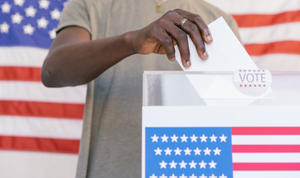America
Potboiler US election in the final stretch, a look at swing states, electoral college

Washington DC, November 5:
In less than 24 hours, the United States voters will head to voting in one of their most consequential elections, which will decide the direction of not just the US but also have influence on the global geo-politics for the next four years. A look at some key elements to go through election and result process.
The Number Game
There are a total of 538 electoral votes in the college; 435 House of Representatives, 100 Senate seats and 3 seats from Washington DC. A candidate needs a minimum of 270 votes to become the President. Every state has a certain number of electoral votes. California has the maximum number of seats with 54, followed by Texas (40) and Florida (30). On the other hand, states like North Dakota, South Dakota, Delaware, and Vermont have a minimum number of 3 seats.
The US system follows the 'Winner takes all' model. Here, the candidate with the maximum number of votes in a state wins all the electoral votes of that particular state. However, the system is applicable in Washington DC and 48 out of the 50 US states. The two states of Maine and Nebraska are the exceptions because they follow a proportional system.
Notably, along with the lower house of the US Congress (House of Representatives), the upper house (Senate) will also see its 34 seats undergoing contest. The entire House of Representatives will be re-elected, while one-third of the Senate will be renewed.
Electoral College and Popular Vote
In the US, the winner is decided by the Electoral College. The Electoral College is an intermediary body that chooses the US President. In this system, voters across all the states cast their ballots to choose the electors of the Electoral College, who then formally vote to elect the President in December. Each state gets a certain number of electors based on the number of seats they have in the House of Representatives and Senate. The rationale behind this is to ensure adequate representation of all the states.
The popular vote, on the other hand, is simply the votes garnered by the candidate. It is pertinent to note that there have been instances when a candidate got more popular votes but lost out on the electoral college. The most recent example of this was in 2016 when Donald Trump trumped Hillary Clinton by 304 electoral votes to 227, despite lagging behind the former First Lady in popular votes by over 2 percentage points and 28 lakh votes. The other similar instance is from 2000 when Republican George W Bush defeated Democrat Al Gore by a close margin in a contest that was eventually decided by the court.
What are the Swing States?
Generally, most of the US states follow a trend of leaning towards one party. The states leaning Democrats are called Blue states, and those leaning Republicans are called Red states. The Swing States, however, are seven battleground states, which don't follow a fixed trend, keep changing and eventually also play the deciding role in selecting the winner.There are mainly seven swing states -- Nevada (6), Arizona (11), North Carolina (16), Georgia(16), Wisconsin (10), Michigan (15), Pennsylvania (19).
History in the making
Despite the presence of many other parties, the US race is between the Democratic and Republican parties. Vice President Kamala Harris is the candidate of the incumbent Democrats, and she is aiming to create history becoming the first woman of the US. If elected, she will also be first Indian-origin President of the United States.
On the other hand, the Republican candidate is former President Donald Trump, who is eyeing a historic comeback to the White House after a bitter exit in 2020. Notably, if Trump wins, it will be the first instance in over 100 years of a president serving two non-consecutive terms in the White House.
Most of the polls have predicted a very close race between Trump and Harris, with all the leads projected within the margin of error. According to the national polls, as provided by the 'five thirty-eight' platform of ABC News, Harris (48) has a minor lead of 1 percentage point against Donald Trump (46.9).
NBC News and Emerson College have projected a 49%-49% tie nationally between the two candidates. Ipsos has projected a three-point lead (49%-46%) to Harris, while, AtlasIntel has projected a two-point lead (50%-48%) to Trump.
Timing of polling and counting
The polling hours will vary across the states, but most locations will vote between 6 am to 8 pm on Tuesday (local time). Though, exit polls will start coming once voting starts, the final results will come only after counting is closed in all states. The first polls will close at around 7 pm ET (5:30 am IST) in six states including Georgia. The final polls will close in the blue state of Hawaii and in the red state of Alaska at 12 am ET (10:30 am IST). Total votes will close by 1 pm ET (11:30 am IST), following which counting will start. The results in small states can be projected soon after polling states, some key battleground states may take hours in projecting the winner.
Source: ANI



































